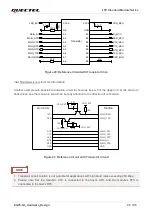
LTE Standard Module Series
EG25-GL_Hardware_Design 33 / 96
3.3.2 Voltage Stability Requirements
The power supply range of the module is from 3.3 V to 4.3 V. Please make sure that the input voltage will
never drop below 3.3 V. The following figure shows the voltage drop during burst transmission in 2G
network. The voltage drop will be less in 3G and 4G networks.
Power
Supply (V)
Burst
Transmission
Ripple
Drop
Burst
Transmission
Load (A)
Figure 7: Power Supply Limits during Burst Transmission
To decrease voltage drop, a bypass capacitor of about 100 µF with low ESR (ESR = 0.7
Ω) should be
used for VBAT_BB and VBAT_RF respectively, and a multi-layer ceramic chip (MLCC) capacitor array
should also be reserved due to its ultra-low ESR. It is recommended to use three ceramic capacitors
(100 nF, 33 pF, 100 pF) for composing the MLCC array, and place these capacitors close to VBAT_BB
and VBAT_RF. The main power supply from an external application has to be a single voltage source and
can be expanded to two sub paths with star structure. The width of VBAT_BB trace should be not less
than 1 mm; and the width of VBAT_RF trace should be not less than 2 mm. In principle, the longer the
VBAT trace is, the wider it should be.
In addition, in order to avoid the damage caused by electric surge and electrostatics discharge (ESD), it is
suggested that a TVS diode with suggested low reverse stand-off voltage V
RWM
4.5 V, low clamping
voltage V
C
and high reverse peak pulse current I
PP
should be used. The following figure shows the star
structure of the power supply.






























